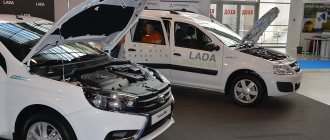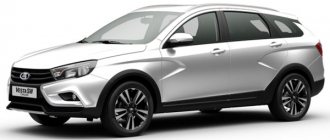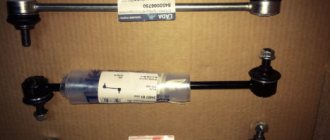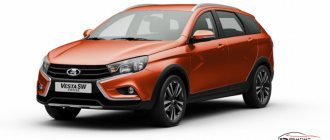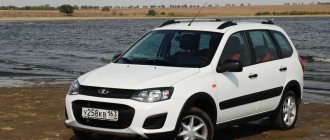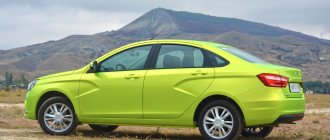The success of the Lada Vesta in the market as a whole, and especially in comparison with previous AvtoVAZ models, could not but receive its logical continuation. In 2021, in the fall, Lada Vesta SW and Lada Vesta SW Cross went on sale. Vesta has already managed to make a name for itself, so there was a sense of excitement over the new products, and the start of sales was successful, however, when comparing the SW cross and the regular LadaVesta station wagon, it is not immediately clear why these are different cars at all? In fact, Lada Vesta and Lada Vesta Cross have differences in many parameters, we will try to highlight the main ones.
Comparison of bodies and wheelbases
Cars from the new AvtoVAZ model line both have decent dimensions, but there are still differences between the Lada Vesta SW Cross and its sister: So, the Cross is 20 mm higher: 1532 mm versus 1512, 21 mm wider: 1785 mm and 1764 mm, longer by 14 mm: 4424 mm and 4410 mm, Vesta SW cross has a 14 mm larger track. The wheelbase of the cars is the same, but the wheels themselves are different. Drivers of a regular Lada SW will have to be content with 15 and 16-inch wheels; the SW cross has 17-inch wheels. In general, Cross is larger in all respects.
Three-volume body
Lovers of sedans, of which we have a surprising number, explain their choice by the fact that in a car with a trunk separated from the passenger compartment, it is quieter, warmer and there are no foreign odors coming from the trunk. Each of these statements can be argued. But we can agree. The trunk volume of this sedan is the same as that of the station wagon (under the shelf) - 480 liters, and the rear seat back also folds in parts.
The volume of the luggage compartment is 480 liters. One “but”: when loading under the lid, you will have to take into account the hinges protruding into the trunk and place things so as not to crush them.
The sedan is also lighter than the station wagon (by 50 kg). And the body is stiffer. This entails better handling. Most likely, the interior will begin to creak later than in the station wagon. However, particularly large items (for example, a packaged washing machine or a kitchen stove) cannot be transported in a sedan. But in a station wagon you can at least try. But this is so, a remark.
Model design
The first glance at a book is always at its cover; you don’t judge the book by it, but you can judge the owner of the car with almost 100% confidence by its design. In their new models, VAZ maintains style. Still the same bias towards sports, which is not surprising, because SW stands for “SportWagon”, all the same stylish X-shaped patterns. But AvtoVAZ nevertheless made a difference between the Lada Vesta SW and the Lada Vesta SW Cross. In terms of body design, we are more impressed by the Vesta Cross, firstly, the color of the Lada Vesta SV Cross is “Mars”, in other words, metallic orange. But more significant is the black plastic body kit; this part protects the most vulnerable spot of the car from scratches, and subsequently, from rotting. A decorative exhaust tip makes the car more sporty and aggressive, while the regular Lada Vesta SW does not look so menacing and daring. Looking at the Vesta SW Cross, you can immediately see that it is for off-road use, which is not too different from what we call roads; its driver is a lover of active recreation in almost extreme places with his family or a group of friends. While the driver of the Vesta SW is also no stranger, but instead of off-road, he relies on any road, but the road, and his passion is not conquering hard-to-reach areas, but active recreation in the country and, of course, barbecues.
Castling in Izhevsk
The start of production of station wagons at , most likely, will cause a slight castling between AvtoVAZ assembly sites. The option of moving the Granta liftback to Tolyatti is being considered, to the line where the co-platform Granta sedan, Kalina and Datsun cars are assembled, and the plant in Udmurtia will focus exclusively on Vesta (the production of Nissan cars was stopped back in April due to low demand).
Last year, Lada Izhevsk, working in two shifts, produced 96 thousand cars (61 thousand were Vesta, 34 thousand were Granta and 1.5 thousand were Nissans). However, in the first five months of 2021, demand for Vesta increased by 60%, and if things continue to progress at a good pace, then by the end of the year the sedan alone will be able to reach the target mark, which was set two years ago at the launch of Vesta - 100 thousand cars per year - and will become the most popular modern AvtoVAZ model. And together with the station wagon, Vesta has an excellent chance of becoming a bestseller in the Russian car market.
Of course, in this situation in Tolyatti the question cannot help but arise, what would happen if Vesta were assembled at a “home” plant? But moving back is no longer possible: AvtoVAZ is gradually increasing the share of components that are produced in Izhevsk, and if previously car transporters delivered power units, chassis components and body parts from Togliatti, now the stamping of almost all large body elements is located at the final
The main question—the price of the station wagon—will remain open until sales start in the fall. But we can guess something.
The Lada Vesta 1.6 sedan now costs from 546 to 686 thousand rubles. If we focus on Kalina, the station wagon is priced at 15 thousand more than the hatchback, but in the case of the Ford Focus sedan and station wagon the difference is ten thousand, and for the Kia cee'd family - 30 thousand rubles. We would venture to assume that the Vesta station wagon will cost an extra 20-25 thousand and, thus, will cost about 570 thousand rubles in the most affordable version.
But with the upper bar everything is more complicated.
The four-door Vesta 1.8 AMT in the top version is now offered for 736 thousand rubles. Versatility will raise the amount to approximately 760 thousand. Plus the Cross version, for which AvtoVAZ in Kalina and Largus charges up to 35 thousand rubles. Plus an additional payment for the fiery metallic color Mars (on Vesta the original colors cost from 12 to 35 thousand). Plus 17-inch wheels, plus a package of improvements...
In total, at least 800 thousand accumulate!
This psychological mark has just been broken by the XRAY in the Exclusive configuration with an interior made of artificial leather and Alcantara: 809 thousand with “mechanics” and 831 thousand with “robot”. However, the VAZ hierarchy gives the pseudo-crossover XRAY a higher status... But something tells me that the Vesta SW, especially in the Cross version, will finally overturn this hierarchy - at least until the XRAY drives at least as well as Vesta.
Chassis and ground clearance
Ground clearance is an important detail for a car that is going to drive off-road; this is exactly what distinguishes the Vesta Cross station wagon from a regular SW. The next extremely important part of station wagons is the suspension. It is clear that new models should have good suspensions, this is indeed the case, the handling and smooth running of the cars are at a high level in comparison even with foreign cars, let alone previous VAZ models. But the features of the SW Cross consist of more advanced shock absorbers and springs, and added suspension settings make the car stiffer and more confident than its city brother.
Unification
The fourth plus is unification. In most parts, components, and body panels, the Cross is identical to the regular Vesta, and in some (body kit, interior) it is identical to the SW Cross station wagon. The suspension is also the same, with the exception of slightly shorter rear springs, which carry less load compared to “universal” springs. By the way, the sedan is more comfortable than the station wagon, not only because it is stiffer and quieter, but also because it is less sensitive to road irregularities.
The car is as unified as possible with other models of the family. It will not be difficult to find spare parts for it, and mechanics will easily cope with any malfunction.
Salon
The first thing that catches your eye is that the Lada Vesta SW Cross has other colors of seats and inserts, namely, echoing the standard color of the car - “Mars”, that is, they are bright orange, making the car quite lively inside. But besides the color and “cross” inscriptions, the interior of the models is absolutely the same, but this does not mean that there is nothing to say about it. Adjusting the front seats allows you to find a truly comfortable position in the car, a comfortable armrest with a large volume for your items, convenient instruments from which the readings can be clearly read, curly inserts in the cabin continue the external design, you won’t forget that you are behind a Vesta. The back seat is simply wonderful: there is enough room for even three, there is more than enough legroom, high ceilings will be especially appreciated by all 180+ cm passengers, chargers, bags on the backs of the front seats, and most importantly - an armrest in the rear seat with cup holders, which generally makes us doubt whether we are sitting in a VAZ car?
Interior
There are no noticeable surprises in the Vesta Cross salon either. Except for a number of contrasting inserts in the door panels and on the center console. Everything else, right down to the upholstery of the seats, was inherited from the SW Cross prototype. By default, the car is offered in a single modification - Luxe. It includes: heated windshield and seats; single-zone climate control system; Hands Free program; four airbags; stabilization system and other useful assistants.
Also, two optional packages have been prepared for the new Vesta. The first - Multimedia is equipped with a front camera and a multimedia system. The second - Prestige - will please the owner with separate heating of the rear sofa, a multimedia complex with navigation, a front camera, a USB socket for charging phones and a rear armrest; illuminated footwells and front door panels, stronger tinted rear windows.
The interior is decorated in one of two styles: with gray or orange inserts. Upholstery materials can be combined with fabric and leather. The center console includes an air conditioning control unit, a small row of main assistant buttons and a 7-inch color touchscreen display. The steering wheel is equipped with a toggle switch for speed limit and climate control. The dashboard is made in the style of a crossover and is illuminated in orange.
There is enough space for everyone in the new Vesta. Passengers on the rear sofa will not have to tuck their legs under them - sitting here is spacious and comfortable. The trunk is absolutely ordinary - a standard compartment for a sedan. It’s just that its complete “emptiness” is extremely surprising and upsetting. There are none of those thoughtful details (nets, hooks, trays and other useful things) that are so successfully implemented in SW Cross. Also an unpleasant surprise was the lack of a hatch for long items.
Engine performance and fuel consumption
The difference between Cross and just Vesta SW in engines and gearboxes lies only in the difference in their combinations. So, a regular station wagon has 16 valve engines of 1.8 and 1.6 liters with 122 and 106 horsepower, respectively. As well as manual and “robot” gearboxes on each of these engines. Vesta SW Cross does not have a “robot” on the 1.6 liter engine. The fuel consumption of a 1.6 liter engine per 100 km is from 7 to 7.3 liters, but the 1.8 liter engine is from 7.6 to 7.8. In general, reviews about the greater technical perfection and convenience of the 1.6 liter engine can be called close to the truth, so you should think twice before than to pay more money for additional volume.
Engines
If you wanted to see motors that are fundamentally different in capabilities and power, then we hasten to disappoint you. The engines of the cars, as well as their appearance, are very similar. On both versions of station wagons, it is possible to install three types of engines and two gearboxes in various variations.
The urban version has a wide variety of choices - there are 4 of them. The crossover version offers only 3 engine and gearbox layout options. In this case, buyers will not have the option of a 1.6 engine paired with an automatic transmission.
You may also be interested in: Do-it-yourself Accent automatic transmission repair
The table shows all possible engine configurations:
Trunk
Fans of active recreation, family trips to the country, simply those who need to transport large volumes - that’s who are looking at station wagons, and the trunk is something that can radically change the decision of a potential buyer. First, we need to note the general things, namely: the double bottom, which noticeably increases the trunk space, AvtoVAZ’s elimination of the shabby folding second shelf in favor of a curtain, the presence of convenient pockets, nets, hooks, and compartments for all transportation options. And of course, general disadvantages: if you want to increase the volume of the already large trunk due to the rear seats, then you will be disappointed, they form a flat surface only with a false bottom, removing it, you will have to store things with a step. The second disadvantage is the high threshold, even with a false bottom; without it, it grows even more, becoming a decent obstacle for especially heavy things. Now let's move on to the differences.
Lada Vesta SW Cross comparison with Lada Vesta SW. The Cross station wagon has an external trunk release button! The designers focused on this part of the car and both Vesta SW are equipped with excellent trunks of 480 liters with a false floor, 575 without it and 875 liters with folded seats. AvtoVAZ gave the SW cars wonderful, spacious trunks in which you can fit any bags, thanks to the large volumes, and fragile things, securing them in additional compartments. The trunk is really not just big, but well-thought-out; for once, a convenient second shelf is an excellent opportunity to avoid putting bags on top of bags, risking damage to the contents. And the folded rear seats form a plane 170 cm long, which means that not only skis, but also a very tired traveler will fit there.
Lada Vesta Cross: 5 advantages and 2 features - Za Rulem magazine
Recently, AVTOVAZ began selling the Lada Vesta Cross sedan, which differs from the regular Vesta by increased ground clearance and a plastic body kit around the bottom perimeter. This is a unique car: there are simply no similar off-road sedans at this price, and especially in the B+ segment. But Vesta Cross also has other features.
Ground clearance
The main and biggest plus of the Russian cross-sedan is its high ground clearance. According to factory specifications, its height is 203 mm. Not every modern crossover can boast the same. High ground clearance is needed if you at least sometimes drive off smooth asphalt. However, it is also useful in big cities with their eternal construction sites, speed bumps and curbs that do not comply with GOST. Now remember how they like to raise the suspension, including on sedans, in the provinces. So, Vesta Cross is definitely in trend.
The Lada Vesta Cross has such ground clearance that even crossovers can envy. And the overhangs are moderate. So the geometric cross-country ability is very good.
The Lada Vesta Cross has such ground clearance that even crossovers can envy. And the overhangs are moderate. So the geometric cross-country ability is very good.
Design
The second noticeable plus is the appearance of the car. Even the ordinary Lada Vesta still arouses interest in many regions. What can we say about a car with increased ground clearance, on 17-inch wheels, with a plastic body kit on the bottom of a bright red body (optional color “Mars”)! No tuning needed. The interior of the Cross is also more elegant than in the regular Vesta, with numerous orange inserts. The “cross” Lada series is also characterized by orange instrument scales
Even if you choose any other of 10 body colors (for example, gray) and gray inserts in the interior, Vesta Cross will still attract attention. Many people are flattered by this
The interior of this car will not let you forget about its pseudo-off-road features. Although psychologists may say that this color combination is too aggressive. The interior of this car will not let you forget about its pseudo-off-road features. Although psychologists may say that this color combination is too aggressive.
Three-volume body
Lovers of sedans, of which we have a surprising number, explain their choice by the fact that in a car with a trunk separated from the passenger compartment, it is quieter, warmer and there are no foreign odors coming from the trunk. Each of these statements can be argued. But we can agree. The trunk volume of this sedan is the same as that of the station wagon (under the shelf) - 480 liters, and the rear seat back also folds in parts.
The volume of the luggage compartment is 480 liters. One “but”: when loading under the lid, you will have to take into account the hinges protruding into the trunk and place things so as not to crush them.
The volume of the luggage compartment is 480 liters. One “but”: when loading under the lid, you will have to take into account the hinges protruding into the trunk and place things so as not to crush them.
The sedan is also lighter than the station wagon (by 50 kg). And the body is stiffer. This entails better handling. Most likely, the interior will begin to creak later than in the station wagon. However, particularly large items (for example, a packaged washing machine or a kitchen stove) cannot be transported in a sedan. But in a station wagon you can at least try. But this is so, a remark.
The fourth plus is unification. In most parts, components, and body panels, the Cross is identical to the regular Vesta, and in some (body kit, interior) it is identical to the SW Cross station wagon. The suspension is also the same, with the exception of slightly shorter rear springs, which carry less load compared to “universal” springs. By the way, the sedan is more comfortable than the station wagon, not only because it is stiffer and quieter, but also because it is less sensitive to road irregularities.
Price difference
Although both cars are station wagons, there are differences in price, and justified ones, so, when we compare the Lada Vesta SW Cross with a more urban version, we find a lot of differences in favor of the first, which, of course, affected the cost.
The base price of Vesta SW is 589,410 rubles, Vesta SW cross is 693,810 rubles. The difference is almost 100,000, for this the unique cross will have: a plastic body kit, “Mars” color, interior trim of the same color, a decorative exhaust pipe nozzle, wider ground clearance, a more advanced suspension and larger wheels, at least an inch. Is it worth 100,000 rubles? You decide. We will just note that in all Vesta AvtoVAZ paid great attention to safety, did not skimp on it, 4 airbags are already included in the most modest configuration, such concern for customers is very pleasant.
Test drive Lada Vesta SV Cross and Vesta station wagon (+photo)
The Lada Vesta sedan has already become quite popular and one of the most purchased cars in Russia. AVTOVAZ decided not to stop there and released two completely new cars: the Lada Vesta station wagon and the Lada Vesta Cross.
The second car is the same station wagon, but with some differences. In this review, we will look at the main differences and test drive the Lada Vesta St. station wagon.
test drive Lada Vesta SV Cross
Comparison of Lada Vesta SV Cross and a regular station wagon
The first thing that catches your eye is the high ground clearance, which is 20 mm higher in the Cross version. This is understandable, because this car is positioned as something between a simple station wagon and a dynamic crossover. Vesta SW Cross has different rims, and the wheel size itself is different. The dimensions of the two cars also differ, although only by a few millimeters and are not particularly noticeable when getting to know the cars.
The usual Vesta has these indicators: 4410 x 1764 x 1512, versus 4424 x 1785 x 1532 for Vesta Cross. Such differences in dimensions are associated with the original plastic body kit, which the advanced version boasts. The body kit performs not only a decorative function, but also protects the car from minor damage to the body. The linings look solid and make the car more sporty.
Specifications
GENERAL DATA Lada Vesta SW1.8 5MT (5AMT) Lada Vesta SW1.6 5MT (5AMT) Lada Vesta SW Cross1.8 5MT (5AMT) Lada Vesta SW Cross1.6 5MT
| Dimensions, mm: length / width / height / base | 4410 / 1764 / 1512 / 2635 | 4410 / 1764 / 1512 / 2635 | 4424 / 1785 / 1532 / 2635 | 4424 / 1785 / 1532 / 2635 |
| front/rear track | 1510 / 1510 | 1510 / 1510 | 1510 / 1510 | 1524 / 1524 |
| Trunk volume, l | 480 / 825 | 480 / 825 | 480 / 825 | 480 / 825 |
| Ground clearance, mm | 178 | 178 | 203 | 203 |
| Curb weight, kg | 1330 | 1280 | 1350 | 1300 |
| Acceleration time 0 - 100 km/h, s | 10,9 (12,9) | 12,4 (14,4) | 11,2 (13,3) | 12,6 |
| Maximum speed, km/h | 180 (182) | 174 (174) | 180 (181) | 172 |
| Fuel / fuel reserve, l | A92/55 | A92/55 | A92/55 | A92/55 |
| Fuel consumption: urban/suburban/combined cycle, l/100 km | 10,6 / 6,3 / 7,8(9,9 / 6,2 / 7,6) | 9,5 / 5,9 / 7,3(9,2 / 5,7 / 7,0) | 10,7 / 6,4 / 7,9(10,1 / 6,3 / 7,7) | 9,7 / 6,0 / 7,5 |
| ENGINE | ||||
| Location | Front transverse | Front transverse | Front transverse | Front transverse |
| Configuration / number of valves | P4/16 | P4/16 | P4/16 | P4/16 |
| Working volume, cubic meters cm | 1774 | 1596 | 1774 | 1596 |
| Power, kW/hp | 90 / 122 at 5900 rpm. | 78 / 106 at 5800 rpm. | 90 / 122 at 5900 rpm. | 78 / 106 at 5800 rpm. |
| Torque, Nm | 170 at 3700 rpm. | 148 at 4200 rpm. | 170 at 3700 rpm. | 148 at 4200 rpm. |
| TRANSMISSION | ||||
| Type | front-wheel drive | front-wheel drive | front-wheel drive | front-wheel drive |
| Transmission | M5 (P5) | M5 (P5) | M5 (P5) | M5 |
| CHASSIS | ||||
| Suspension: front/rear | McPherson / elastic beam | McPherson / elastic beam | McPherson / elastic beam | McPherson / elastic beam |
| Steering | rack and pinion with electric booster | rack and pinion with electric booster | rack and pinion with electric booster | rack and pinion with electric booster |
| Brakes: front / rear | disk / disk | disc / drum | disk / disk | disc / drum |
| Tire size | 185/65R15 or195/55R16 | 185/65R15 or195/55R16 | 205/50R17 | 205/50R17 |
The front and rear bumpers have an aerodynamic appearance, and a decorative exhaust tip complements the dynamic styling. The last external difference of the Cross is the unusual orange coloring, which. This color is only available for this modification.
We go further, the Vesta Cross track is 14 mm wider. There are different shock absorbers and springs here, and the suspension has slightly different settings compared to the station wagon. We look into the salon and what do we see?
The interior has an original orange finish, the color scheme of which matches the body paint, and a full package of options, parts of which are also available on a regular station wagon, although in this case you will have to pay extra for them. It is worth noting that a wide package of opiums is also available on a regular station wagon, and paying essentially the same money, the user will receive the same functionality.
salon Vesta cross station wagon
True, the purchased car will not have cool seventeen-inch wheels and a sporty appearance. Both models have a unique design and have the characteristic features of the signature X-style.
This is noticeable at the front of the cars: the headlight surrounds continue into the radiator grille and, together with the air intake, form the letter “X”. The sports seats in Vesta Cross also have an “X-shaped” pattern that complements the image of the car.
The maximum configurations of both cars are replete with large displays on the center console, a stylish parting panel, a functional steering wheel and all sorts of useful things, such as an armrest in the rear sofa, with two holes for a glass or bottle (this detail is a sign of an expensive car). What specifically pleased me about both modifications was the abundance of space in the cabin and trunk.
If the first aspect is formed mainly due to the considerable external dimensions of the model, which create the illusion of a huge interior (although it is really quite large), then the luggage compartment looks truly impressive and has a double floor, which, together with the main space, amounts to as much as 775 liters. And if you lower the rear seat, you can get another 50 liters.
The entire trunk is dotted with various functional shelves, cargo support nets and hooks. Two lamps located on the sides of the trunk provide illumination. Well, now let’s move on directly to the test drive of these two AvtoVAZ new products.
Test drive Lada Vesta SV Cross
Both models have several trim levels, each with a specific engine and transmission combination. All three Vestas, including the sedan, are equipped with two engines: 1.6 and 1.8 liters with a volume and power of 106 and 122 hp. respectively.
In terms of transmission, the buyer can choose between manual and robotic automatic transmission. When Vesta sedans first came out, the manufacturer installed a French manual transmission on them, but then decided to abandon it in favor of a domestic development. For a test drive, we’ll take two powerful cars with a 1.8 engine capacity and a manual gearbox.
Why this particular combination? Because these are the most dynamic and nimble cars of the entire series. No, of course, the robot is also not bad, but it is not designed for fast and harsh driving, which is necessary for a test drive. And the impression of the car will be blurry if you take different combinations of engine and transmission. The Lada Vesta SW accelerates to the first 100 km in 10.9 seconds, which is not much, but for a car of this type it is quite acceptable: on the highway, the car will not “graze the rear”.
Even with the trunk and interior fully loaded, Vesta with a more powerful engine will have more traction than the same car, but with a 1.6 engine and a half-empty interior. Back in the days of the sedan, many drivers realized that the car handled well, held turns, and steering wheel manipulations did not cause migraines. Everything is the same here, and in some aspects even better, especially when it comes to the Cross version.
This car, despite the increased ground clearance, does not create a feeling of roll. This is understandable, the suspension is specially tuned here, and the wheels are different from a regular station wagon. The suspension of both cars allows you to ignore potholes and smoothes out minor road irregularities. The increased stiffness of the springs in the Vesta Cross allows you to make sharp turns without rolling from one side of the cabin to the other.
In addition to increased stability properties, the Cross confidently drives through mountainous terrain through holes and potholes. AVTOVAZ brought the suspension to mind, making it impenetrable. Despite its name, this car is not intended for steep slopes and off-road conditions, but even with these tasks it copes very well.
In the combined cycle, a 1.8 engine with manual transmission consumes 7.9 liters per 100 km. In urban conditions the mark reaches ten, which is quite a lot. But for the agility of the “engine”, the gluttony can be forgiven.
Both the station wagon and the Cross evoke only pleasant sensations from being in the cabin. It is spacious, comfortable and ergonomic. When you are in a car, you feel protected from all sides. A test drive of Vesta SW and Vesta SW Cross leaves a pleasant impression. Both cars perform well in all conditions. Of course, the station wagon loses to the Cross in some ways, but this is so insignificant that you can not pay attention to it.
The cars are not designed for heavy off-road use, but they do allow you to go fishing, have a picnic, or plunge into the rural landscape.
The biggest advantage of these two machines is the almost complete absence of competitors in the domestic market. This is because the cars turned out to be quite original. They can serve as both an everyday workhorse and as transport for family trips with a lot of luggage. In addition, this is an all-terrain station wagon and it is unlikely that anyone will be able to compete with it.
Similar models from competitors cost an order of magnitude higher, and it makes sense to overpay for them if there is an opportunity, as they say, to “support a domestic manufacturer,” and even get a good, nice machine with excellent functionality for its price category.
See also:
Fast passage:
ixray.ru
Transmission
The gearbox in the new Vesta SW is of two types: “robot” and mechanical, and in the crossover with a 1.6 liter engine there will be no “robot”. Let's start with the mechanics. Here we must pay tribute, the reworking of the gears of old models and foreign parts did their job, changing gears is easy and pleasant. But what about the "robot"? Is it really so good that they don’t even put it on a smaller cross-country engine in order to provoke the purchase of a larger one? Rather, on the contrary, the VAZ robot is very far from ideal, it sucks all the pleasure that a manual transmission can provide, our condolences to all those who don’t like it, of course, this is not a detail that should scare you away from the car, but Vest’s mechanics are really nice .
The robot has been upgraded!
Since February, Vesta received version 2.0 gearbox (as it is called at the factory). It works 40% faster by optimizing the algorithms for the operation of servo drives when switching. A “creeping” mode has appeared, like in conventional automatic machines - the car now starts moving when the brake pedal is released (it is not necessary to press the gas).
Finally, a winter mode has been added, in which Vesta starts from the second stage - this should provide smoother starts on snow and ice. But we were not able to evaluate all these innovations, because the test included cars only with manual transmission and a 1.8 engine! So we’ll have to take Vesta separately again, but for now we’ll take the VAZ people’s word for it.
Underpay for
Crossovers are the fastest growing segment of the Belarusian car market, and Hyundai Creta is one of the popular models in this class. But won't the situation change with the advent of the Lada Vesta SW Cross station wagon, just as practical, but more affordable? We decided to find out whether it makes sense to overpay for Creta when you can underpay for Vesta SW Cross.
All power to crossovers!
Golf class sedan? Yes, we have already forgotten what it is! Crossovers are in fashion today, which, despite their higher price, displace regular passenger cars from the top 10 sales. A real example: in 2017, a Hyundai dealer sold 845 Creta crossovers in Belarus, while the Accent sedan sold only 621 cars.
The Lada Vesta SW Cross all-terrain station wagon cannot yet boast of such successes, since its sales started only at the end of 2021. But if you consider that this is, in fact, the only pseudo-off-road station wagon on the market, and also quite beautiful, the prospects look very rosy. Many buyers see the Cross as an alternative to a crossover. Are such hopes justified? Is it worth overpaying for a crossover or is it really better to take a raised station wagon? And is Lada even able to stand comparison with Hyundai?
In the budget segment, sedans rule the roost, but Lada bet on a station wagon and was right, because there are practically no competitors
How much?
As mentioned above, the Lada Vesta can be a station wagon in two guises - a regular SW and an elevated SW Cross. The difference between them is the ground clearance (178 and 203 mm), as well as the protective plastic around the perimeter of the body, which is a feature of the Cross version.
At the same time, Cross is considered a more status model and is not offered in basic versions, which significantly affects the price. If a regular SW with a 106-horsepower 1.6-liter engine is available starting with the Comfort package and costs from 23,420 Belarusian rubles, then Cross 1.
6 in our market is offered at least in the Luxe configuration and costs 27,820 Belarusian rubles (for comparison: Lada Vesta SW Luxe 1.6 will cost 25,880 rubles).
The SW Cross Luxe's equipment is very good - front and side airbags for front passengers, ISOFIX, daytime running lights, fog lights, all electronic assistants, including TCS and ESC, on-board computer, central armrest with box, double luggage compartment floor, electric power steering , adjustable steering wheel for height and reach, cabin air filter, light tinted windows, central locking with folding key control, front and rear electric windows, 3-level heated front seats, heated and electric mirrors, heated windshield, parking sensors, rain sensors and lights, climate control and cooled glove box, multifunction steering wheel and audio system with 4.3-inch monochrome display, rear spoiler, 17-inch alloy wheels, decorative exhaust tip, two-tone interior - what more could you want? Normal multimedia system. And it comes in the Luxe Multimedia package (as on the test car) - with navigation and a 7-inch color touchscreen. This Vesta SW Cross with a 1.6-liter engine costs 28,710 Belarusian rubles, and with a 122-horsepower 1.8-liter engine costs 29,640 rubles. The most expensive Vesta SW Cross is the Luxe Prestige version with a 1.8-liter engine and an AMT robotic gearbox, for 31,220 Belarusian rubles.
Hyundai Creta has already become familiar, but it looks well-built and harmonious
The price list for the Hyundai Creta starts even higher - for the basic front-wheel drive Active version with a 1.6-liter 123-horsepower engine they ask for 33,900 Belarusian rubles.
The equipment of the base Creta is also quite good - all assistants, led by a stabilization and traction control system, heated seats and mirrors, power windows, central locking with key control, an audio system with steering wheel controls, etc.
However, in the basic version there are only 2 front airbags, instead of climate control there is air conditioning, and the steering wheel in the initial versions is adjustable only in height. Do you want to upgrade? Then, if we are talking about a front-wheel drive version with a manual transmission, you will have to step up one configuration, to the Travel version, which costs 37,900 Belarusian rubles.
Its equipment is noticeably better: there are side and window airbags in the front, rear parking sensors and tire pressure sensors, daytime running lights are LED, the steering wheel is adjustable for reach and equipped with heating, the wheels are shod with 16-inch alloy wheels (for basic Cretas - “stamping” "), optitronic instrument panel, climate control and additional high-frequency speakers in the doors.
To get a heated windshield, an audio system with a 5-inch color display, light sensors, cruise control and other nice little things, you will have to step even further, to the mark of 39,900 Belarusian rubles, which are asked for the Elegance package. In general, the difference between the front-wheel drive Lada Vesta SW Cross 1.8 and Hyundai Creta 1.6 (both with manual transmission) in more or less comparable configurations is quite significant.
Is this an extra payment for better quality, brand or the proud title of a crossover? Let's see.
What is inside?
In the Elegance package (only the Style is higher), the interior of the Hyundai Creta looks neatly conservative, but you can immediately feel how meticulous the Koreans are in creating configurations.
Even in this far from basic version, the multimedia system screen has a diagonal of only 5 inches, which especially attracts attention when the rear view camera is activated - the image looks very small. The steering wheel is covered with the finest leather that is very pleasant to the touch, but the handbrake and gearbox levers are plastic.
They even managed to make the steering wheel adjustment for reach a privilege of expensive versions; the basic ones only have height adjustment. But it’s nice that not only the front but also the rear seats, as well as the steering wheel, are heated.
The interior of the Hyundai Creta is not very expressive, but is almost flawless in both ergonomics and quality
The build quality and ergonomics are impeccable. The plastic is pleasant to the touch, all the gaps are made simply with filigree precision, the comfortable seat has height adjustment, and the steering wheel, as mentioned above, has height and reach adjustments. All the little details, such as internal door handles, all kinds of handles and switches, were carefully worked out. Bottom line: the Creta may look a little boring inside, but we have absolutely no complaints about the quality and ergonomics. Adjusted for the fact that this is still a relatively budget car.
The interior of the Vesta SW Cross is memorable for its design and bright textures, but the materials are a little rougher
We talked about the ideal ergonomics of Vesta in the first tests of sedans two years ago and today we are ready to confirm: in terms of ease of entry, Lada is one of the best in its and neighboring segments. The range of adjustments for the steering wheel and driver's seat is especially impressive.
The work of the designers can also be praised - it is original and memorable, and there are no questions about convenience. But according to Vesta materials it’s simpler. This also applies to multi-textured plastic, bright inserts on the doors, and a steering wheel without leather upholstery.
The build quality can be called amazing for a Russian car, but if we talk about the interior in comparison with the Creta, then objectively it looks and feels cheaper. Which is quite logical: Lada is cheaper.
Who lives well behind?
Passengers of the Vesta SW Cross will not feel constrained even behind a tall driver, but some will find the back angle too vertical. Heating is only available with the Prestige package
Changing to the back row behind you, even a tall person will not feel constrained in the Lada - there is plenty of room in the knees.
And if the driver has also raised his seat, then you can stretch your legs slightly, although in this position you feel the lower crossbar of the seat with your shins. The width of the cabin at the elbow level of the Lada is impressive - 150 cm, so the rear passengers will not feel any constraint. The central tunnel practically does not protrude into the cabin, which will certainly please the third passenger.
There are pockets in the backs of the front seats, but there is no center armrest. Another nuance is that the back of the rear seat is installed unusually vertically.
In terms of interior width, the Creta is slightly inferior to the Lada, but rear seating is more comfortable and there are heated seats
In the Creta, the seat back is set at a more comfortable angle, and the seats themselves are higher, which makes the seating more comfortable. The central tunnel also practically does not interfere with the legs, the feet fit comfortably under the front seats, but there is no armrest in the back either, and there is a pocket only on the back of the navigator’s chair. In terms of interior width, the Creta is slightly inferior to the Lada - at elbow level it is 144 cm, but rear passengers can enjoy heated seats.
Luggage cases
The luggage compartment of the Lada Vesta SW Cross is impressive both in size and convenience - it has niches in the sides, organizers, and a spacious underground
The trunk is the station wagon's calling card, and Lada displays it with pride. The standard volume is 480 liters, in the floor there are two organizers with lids, and under them there is also a spacious underground, in a niche with a spare wheel. Little things can be shoved around so that you won’t find them right away! Larger items can be stored in niches on the sides - on the right there is a box that closes with a lid, on the left there is a mesh and Velcro for fixation. The doorway width is 97 cm, the maximum trunk width is the same.
The trunk of the Hyundai Creta is smaller in capacity, but the doorway is wider and the width of the trunk itself is larger
For carrying luggage, the Hyundai Creta offers less usable volume - 403 liters. But its trunk itself is more convenient for transporting large items, so the width of the opening and the trunk itself is noticeably larger - 110 cm versus 97 for the Lada. Otherwise, everything is similar: there is a niche in the underground near the spare wheel, and there are side pockets with Velcro.
Main Differences
The changes made to the Vesta Cross affected some dynamic and driving characteristics that differed from the usual sedan.
- Increased ground clearance made it possible to use the car in more difficult road conditions. When moving along country and forest roads, you don’t have to be afraid of large bumps, stones, and passes. On a regular sedan you need to be more careful.
- 17-inch wheels affected fuel consumption . Compared to a simple Vesta, on Cross it is slightly higher.
- Appearance . The plastic body kit and signature Mars orange color add to the appeal. The car looks bolder, more aggressive.
- Offered configurations . Vesta Cross is presented in only six expensive “Luxe” trim levels, while a regular sedan offers twenty-two - from the minimum “Classic” to the maximum “Exclusive”.





